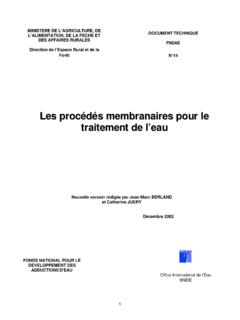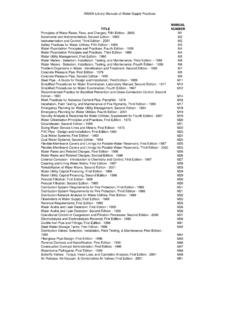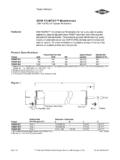Transcription of Fundamentals of Membranes for Water Treatment
1 Fundamentals of Membranes for Water Treatment Alyson Sagle and Benny Freeman1 Introduction Membranes emerged as a viable means of Water purification in the 1960s with the development of high performance synthetic Membranes . Implementation of Membranes for Water Treatment has progressed using more advanced Membranes made from new materials and employed in various configurations. An increasing scarcity in fresh Water sources fueled a push towards alternative resources such as ocean Water . In the 1970s, exploration began into using Membranes for Water desalination.
2 Proving successful at producing purified Water from salt Water , Membranes became a viable alternative to evaporation-based technologies in the Water Treatment market. Over the years, purified Water standards have become more stringent, and a plethora of new applications have appeared. However, Membranes have risen to the challenge and continue to perform efficiently and effectively1. Background Types of Membranes . Water Treatment processes employ several types of membranes1. They include microfiltration (MF), ultrafiltration (UF), reverse osmosis (RO), and nanofiltration (NF) Membranes (Figure 1)2.
3 MF Membranes have the largest pore size and typically reject large particles and various microorganisms. UF Membranes have smaller pores than MF Membranes and, therefore, in addition to large particles and microorganisms, they can reject bacteria and soluble macromolecules such as proteins. RO Membranes are effectively non-porous and, therefore, exclude particles and even many low molar mass species such as salt ions, organics, NF Membranes are relatively new and are sometimes called loose RO Membranes .
4 They are porous Membranes , but since the pores are on the order of ten angstroms or less, they exhibit performance between that of RO and UF membranes3. Nominal Pore Diameter ( )1101001000 MFUFNFRON ominal Pore Diameter ( )1101001000 MFUFNFRO Figure 1. Range of nominal membrane pore sizes2. 1 University of Texas at Austin 1 membrane Characteristics. Membranes are generally classified as isotropic or anisotropic. Isotropic Membranes are uniform in composition and physical nature across the cross-section of the membrane .
5 Anisotropic Membranes are non-uniform over the membrane cross-section, and they typically consist of layers which vary in structure and/or chemical composition. Isotropic Membranes can be divided into various subcategories. For example, isotropic Membranes may be microporous. Microporous Membranes are often prepared from rigid polymeric materials with large voids that create interconnected pores3. The most common microporous Membranes are phase inversion Membranes (Figure 2a)3. These are produced by casting a film from a solution of polymer and solvent and immersing the cast film in a nonsolvent for the polymer.
6 Most polymers used in such applications are hydrophobic, so Water is the most common nonsolvent4. Upon contact with Water , the polymer precipitates to form the membrane . Another type of microporous membrane is the track-etched membrane (Figure 2b)3. This type of membrane is prepared by irradiating a polymer film with charged particles that attack the polymer chains, leaving damaged molecules behind. The film is then passed through an etching solution, and the damaged molecules dissolve to produce cylindrical pores, many of which are perpendicular to the membrane surface.
7 A less common microporous membrane is an expanded-film membrane (Figure 2c)3. Expanded film Membranes are oriented crystalline polymers with voids created by an extrusion and stretching process. First, the material is extruded near its melting temperature using a rapid draw-down rate. Then, the extruded material is cooled, annealed, and stretched up to 300% of its original length. This stretching process creates slit-like pores ranging in size from 200 to 2500 . Isotropic Membranes can also be dense films which either lack pores or contain pores that are so small as to render the membrane effectively non-porous3.
8 These films are prepared by solution casting followed by solvent evaporation or melt extrusion. (a) (b) 1 m (c)Figure 2. SEM images showing top surfaces of a) a phase inversion membrane5, b) a track-etched membrane5, and c) an expanded film membrane6. 2 (a) (b)Figure 3. SEM images of a) cross-section of an anisotropic microporous membrane7 and b) cross-section of a thin-film composite membrane8. There are two main types of anisotropic Membranes : phase separation Membranes and thin film composite Membranes .
9 Anisotropic phase separation Membranes are often called Loeb-Sourirajan Membranes , referring to the people who are credited with initially developing them3. These phase-separated Membranes are homogeneous in chemical composition but not in structure. Loeb-Sourirajan Membranes are produced via phase inversion techniques such as those described above, except that the pore sizes and porosity vary across the membrane thickness (Figure 3a). Loeb-Sourirajan Membranes often consist of a rather dense layer of polymer on the surface of an increasingly porous layer.
10 Thin film composite Membranes are both chemically and structurally heterogeneous (Figure 3b)3. Thin film composites usually consist of a highly porous substrate coated with a thin dense film of a different polymer. They can be made via several methods including interfacial polymerization, solution coating, plasma polymerization or surface treatment3. The descriptions above of isotropic and anisotropic Membranes refer to flat sheet configurations. However, Membranes can also be produced as hollow fibers3.










